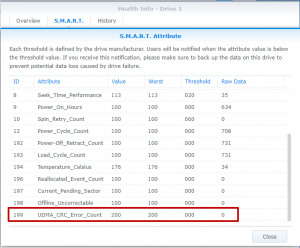
I then configured the Synology NAS from scratch, used Btrfs (instead of ext4), restored the backups. I also zero’d the metadata and MBR off all the drives. I went ahead and backed up my data, deleted the arrays, performed a factory reset on the Synology Disk Station.
#Synology drive crashed but healthy update#
Update April 21st, 2020 – What I thought was the fixĪfter a few more serious crashes and lockups, I finally decided to do something about this. I’m officially going to start planning on either retiring this device as this is unacceptable, especially in addition to all the issues over the years, or I may try an attempt at hacking the Synology Diskstation to run my own OS. The device is responding to pings, and still provides access to SMB and NFS, but the web GUI, SSH, and console access is unresponsive. After restarting the hosts, the Synology device has gone in to a lock-up state once again. Today I had to restart my 3 ESXi hosts that are connected to the NFS export on the Synology Disk Station.

Update May 2nd, 2020 – It’s still crashing, and really frustrating me I still have plans to hack the Synology NAS and put my own OS on it. I went ahead and stopped using NFS, started using iSCSI with MPIO, and the stability of the Synology NAS has greatly improved. Update May 31st, 2020 – Increased StabilityĪfter troubleshooting I noticed that the majority of stability issues would start occurring when ESXi hosts accessing NFS exports on the Synology diskstation are restarted. synopkg uninstall SynoFinderĭoing this resolved the issue and freed up tons of memory. To uninstalling the Indexing service, run the following command. While it did work, and the memory was instantly freed, the setting did not stay persistant on boot. Please note, this needs to be run as root (use “sudo su” to elevate from admin to root). I went ahead and SSH’ed in to the unit, and ran the following commands to turn off the service. In my case, I only use my Synology NAS for an NFS/iSCSI datastore for my ESXi environment, and do not use it for SMB (Samba/File Shares), so I don’t need the indexing service. The fix (Please scroll down and see updates) On a fresh boot of the NAS, it would consume over 500MB of memory. Finally the kernel would panic and attempt to reduce memory usage once the swap file had filled up (keep in mind my DS1813+ has 4GB of memory).Īnalyzing “top” as well as looking at processes, I noticed the Synology index service was causing excessive memory and CPU usage. I also noticed that the issue would occur when restarting any of my 3 ESXi hosts, and would definitely occur if I restarted more than one.ĭuring the restarting, while logged in to the web GUI and SSH, I was able to see that the memory (RAM) usage would skyrocket. This occurred for over a month until it started to interfere with ESXi hosts. I’m currently running DSM 6.2.2-24922 Update 2. This is extremely risky as it can cause data corruption. When this occured, I would need to press and hold the power button to force it to shutdown, or pull the power. In this state, NFS sometimes would become unresponsive. The Synology DS1813+ would become unresponsive and I wouldn’t be able to SSH or use the web GUI to access it.

Once I upgraded my Synology NAS to DSM 6.2 I started to experience frequent lockups and freezing on my DS1813+.


 0 kommentar(er)
0 kommentar(er)
